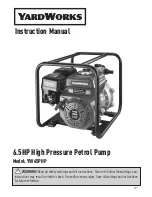
Replacing the wear ring
When the clearance between the impeller skirt and the pump casing exceeds 0.08 in, the following replacement
must be made.
Replacing the wear ring in the pump casing
1.
Disconnect and lift off the motor section from the pump casing.
2.
Knock out the wear ring using a chisel.
3.
Remove the wear ring.
4.
Drive in the new wear ring. Use a rubber mallet or wooden block to prevent deformation.
The work will proceed more easily if the pump casing is first heated and/or the wear ring cooled.
Replacing the impeller
Removing the impeller
WARNING. Worn impellers often have very sharp edges.
1.
Remove bolts and lift the motor section of the pump casing.
2.
Lay the motor section on its side.
3.
Remove the impeller screw.
4.
Pull off the impeller. (Use impeller puller or two strong screwdrivers.)
Installing the impeller
1.
Make sure that the end of the shaft is clean and free of burrs. Polish off any flaws with fine emery cloth.
2.
Clean and oil all sealing surfaces and O-rings.
3.
Check that the conical sleeve is seated on the shaft.
4.
Grease end of shaft and impeller hub.
5.
Mount the impeller and tighten the impeller screw.
6.
Check that the impeller can be rotated by hand.
7.
Fit the motor section to the pump casing. Make sure that the pump casing has the right orientation.
Troubleshooting
A universal instrument (VOM), a test lamp (continuity tester) and a wiring diagram are required in order to carry
out troubleshooting on the electrical equipment.
Troubleshooting shall be done with the power supply disconnected and locked off, except for those checks which
cannot be performed without voltage.
Always make sure that there is no one near the pump when the power supply is turned on.
Use the following checklist as an aid to troubleshooting. It is assumed that the pump and installation have formerly
functioned satisfactorily.
Electrical work shall be performed by an authorized electrician.
Follow local safety regulations and observe recommended safety precautions.
1. Pump fails to start
Is an alarm signal indicated
Yes
Check the cause:
on the control panel?
- If the bearing temperature is high, take the
pump to the shop for repairs.
No
- If the stator temperature is high, check that
the cooling system is working and that the
Impeller rotates easily.
- If there is a fault in the thermistors/thermal
switches, contact a service shop.
Check that the overload protection is reset.





































